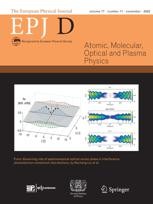Breaking up amino acids with radiation
A new study describes how the amino acid, glutamine, is broken up when bombarded with different doses of electrons. This has implications for cancer radiotherapy and understanding the origin of life.
New York | Heidelberg, 5 February 2020 Small organic molecules, including the amino acids that form the ‘building blocks’ of proteins in living cells, fragment to form ions under the impact of high-energy radiation such as electron beams. A new study published in EPJ D has now shown what happens when electrons collide with one amino acid, glutamine. The extent of the damage and the nature of the ions formed are both affected by the energy of the colliding electrons. This work arises from a collaboration between experimental physicists led by Alexander Snegursky at the Institute of Electron Physics, Uzhgorod, Ukraine and theoreticians led by Jelena Tamuliene at Vilnius University, Vilnius, Lithuania.
Small organic molecules, including the amino acids that form the ‘building blocks’ of proteins in living cells, fragment to form ions under the impact of high-energy radiation such as electron beams. A new study published in EPJ D has now shown what happens when electrons collide with one amino acid, glutamine. The extent of the damage and the nature of the ions formed are both affected by the energy of the colliding electrons. This work arises from a collaboration between experimental physicists led by Alexander Snegursky at the Institute of Electron Physics, Uzhgorod, Ukraine and theoreticians led by Jelena Tamuliene at Vilnius University, Vilnius, Lithuania.
The damaging effect of very high-energy radiation on human tissue is well-known from disasters such as the nuclear accidents at Chernobyl and Fukushima. However, the long-term effects experienced by survivors of such disasters, including an increased risk of cancer, are partly caused by the impact of rather lower-energy radiation. The groups chose to study the effect of electron impact on amino acids because they are less widely studied in this context than DNA.
Snegursky and his colleagues used mass spectrometry to measure the mass-to-charge ratio and thus determine the nature of chemical fragments produced when one biologically important amino acid, glutamine, was bombarded with uniform electron beams with different radiation doses. Meanwhile, the theoretical team modelled the electronic and geometric structures of glutamine and its fragments using quantum mechanics. The observed fragmentation patterns differed according to the radiation dose that the molecules received, and the experimental results were largely borne out by the simulations. The study authors believe that this basic research will have implications for understanding the effect of ionising radiation on human cells, improving the selectivity of radiotherapy beams for cancer cells, and even, perhaps, understanding the origin of life.
References: J. Tamuliene, L. Romanova, V. Vukstich and A.Snegursky (2020) High-energy ionizing radiation influence on the fragmentation of glutamine, European Physical Journal D 74:13, DOI: 10.1140/epjd/e2019-100523-7
Further Information
For more information visit: www.epj.org
Services for Journalists
The full-text article is available here.
Contact
Sabine Lehr | Springer | Physics Editorial Department
tel +49-6221-487-8336 | sabine.lehr@springer.com
